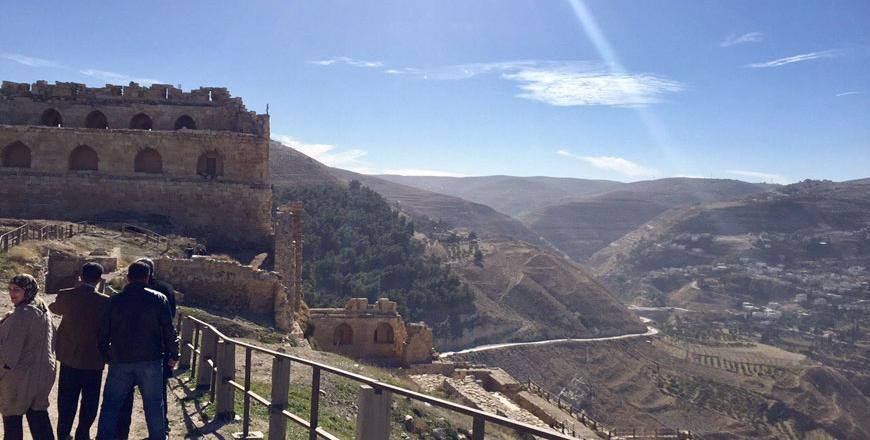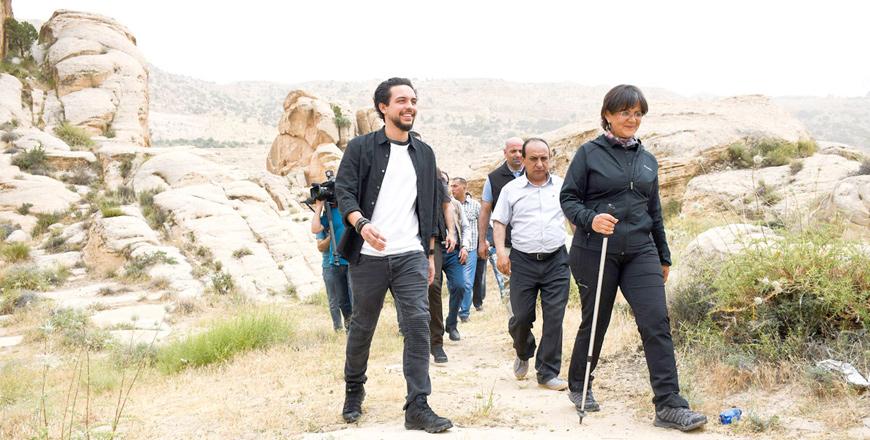You are here
Ministry says several projects planned to boost tourism, security in Karak
By Suzanna Goussous - Jan 14,2017 - Last updated at Jan 14,2017

Karak Castle is one of the largest Crusader fortresses in the Levant (Photo by Suzanna Goussous)
KARAK — With Karak residents calling for better services to revive the tourism sector in the southern governorate, Tourism Ministry officials said work is under way on several projects to develop the sector.
Karak resident Khalil Shurafa said on Thursday that members of the local community in the governorate, over 140km south of Amman, have been demanding services that ensure the safety of tourists, visitors, and residents, including installing cameras and lights and enhancing security around the Crusader castle and other attractions.
“We will do whatever it takes to ensure safer conditions for the people here and tourist groups that visit,” Shurafa said.
During a visit to the southern governorate, the ministry’s secretary general, Issa Gammoh, said there are several projects under way around Jordan, including in Karak, to boost the tourism sector. He put the projects’ overall cost at around JD4.5 million.
Minister of Tourism and Antiquities Lina Annab said the ministry will install security cameras, lights and guiding signs at various tourist attractions to serve visitors.
The projects planned for Karak include establishing a cultural museum in the city centre; installing lights and cameras inside and around Karak Castle as well as a security barrier; implementing the “Birkeh” bus terminal for tourist groups; repairing the cracks in the castle’s walls; and revamping Wadi Bani Hammad for eco-tourism.
Karak Castle was reopened to visitors earlier this month after 18 days of closure following December’s terror attack, in which seven security personnel, two civilians and one tourist were killed. The four attackers were also killed.
One of the largest Crusader castles in the Levant, with an area of 24,000 square metres, Karak Castle is a “dark maze of stone-vaulted halls and endless passageways”, according to the Jordan Tourism Board’s website.
The “Birkeh” bus terminal, which will be operated by the Karak Municipality, will provide medium-sized shuttle buses for tourists in Karak to limit traffic congestion, Annab explained during the visit on Thursday.
Gammoh said the station will also offer services to the local community, noting that job opportunities will be available to residents of the area as soon as the project is implemented.
He added there is a plan to utilise old houses in Karak as part of tourist attractions, placing them on the tourism map.
The ministry is also drafting plans for the National Tourism Strategy, starting from the governorate level by meeting representatives and public and private sector stakeholders from each governorate to discuss the challenges and potential projects, the officials said.
“The local community plays a huge role, because they know the area better… [they are] the ones who can successfully utilise these sites. It’s a partnership,” Annab told The Jordan Times during the Karak tour.
Awni Kawar, the vice chairman of the Jordan Inbound Tour Operators Association (JITOA), said Karak is a main destination for tourists, as it lies at the centre of the “King’s Highway” that crosses the Kingdom from north to south.
“After the terror attack in Karak, travel agents and companies asked us to temporarily avoid Karak,” he told The Jordan Times.
Tour guide Ibrahim Semrin said the sites in Karak tell stories of Jordan’s history and the people who had lived in its land.
Semrin said when the terror attack hit the southern governorate, tour groups went to Shobak, 180km south of Amman, instead to ensure visitors’ safety.
Despite the challenges, Annab said 2016 was “a good year for tourism”, citing a 3 per cent increase in overnight visitors.
The number of visitors to the ancient city of Petra, 235km south of Amman, increased by 14 per cent, while the number of those visiting Wadi Rum rose by 60 per cent.
A 25 per cent increase was marked in the number of visitors to the Baptism Site last year, she noted, citing preliminary figures.
“Another good thing in our numbers this [past] year is the segment of domestic tourism… the share of Jordanians visiting our sites is growing, and this is something promising because it makes us less reliant on foreign visitors,” Annab added.
Related Articles
AMMAN — EU ambassadors on Thursday visited Karak in a show of solidarity and to highlight that Jordan, including the southern governorate, i
AMMAN — Tourist numbers surged last week due to the Labour Day long weekend, Tourism Minister Lina Annab said on Monday during a briefing wi
AMMAN — HRH Crown Prince Hussein on Thursday visited the village of Al Sele and its namesake castle, and was briefed on the Ministry of Tour













